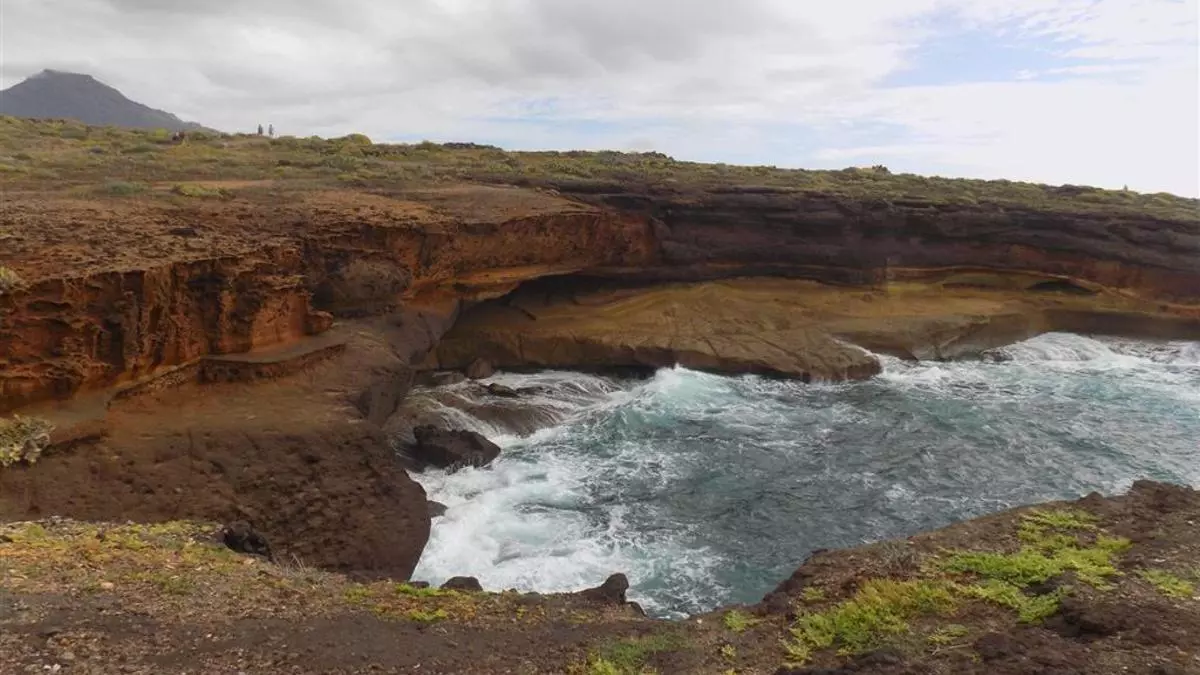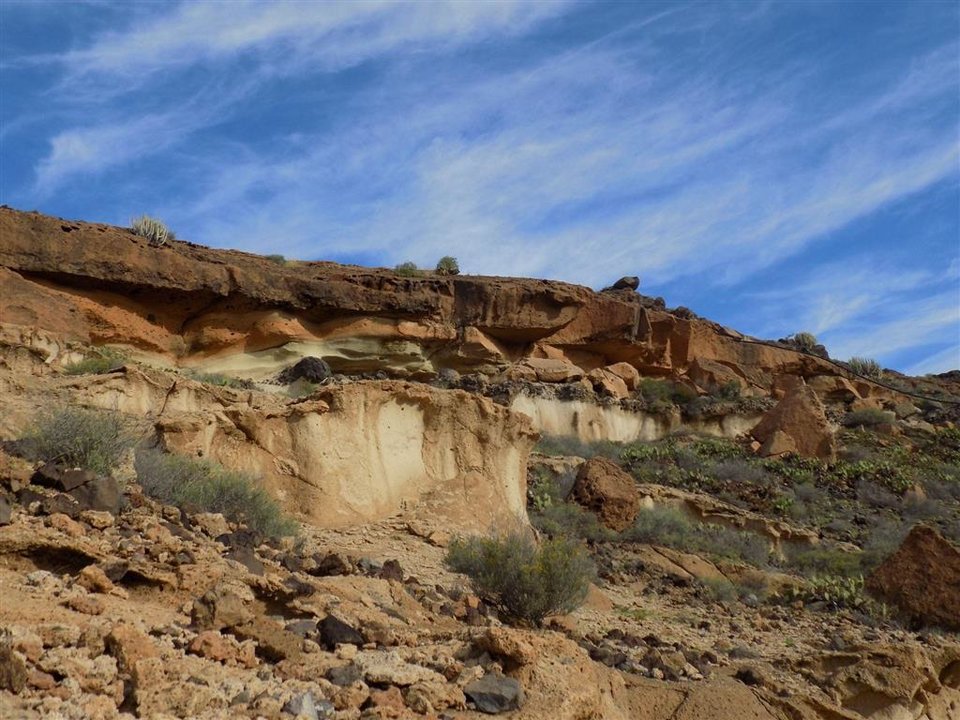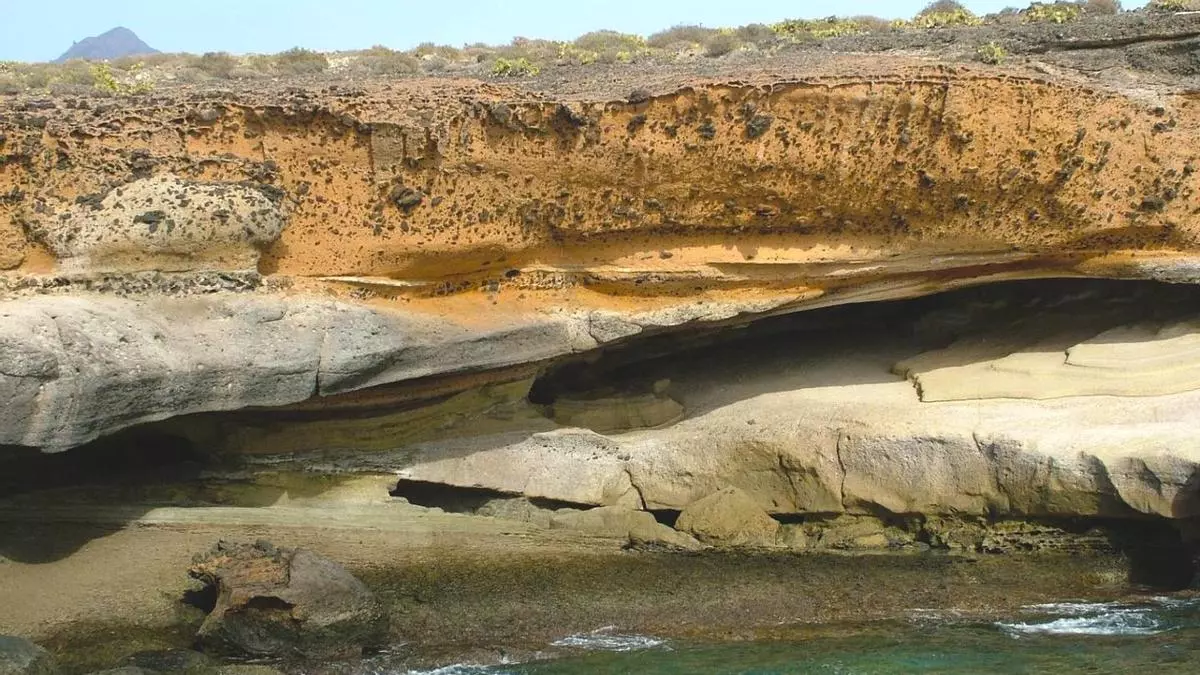Press release: Puertito de Adeje becomes a site of geologic interest
By GeoTenerife

Nota de prensa 🇪🇸🇮🇨
Sábado 21 de Septiembre 2024
GeoTenerife La geología del Puertito de Adeje es parte del catálogo de Lugares de Interés Geológico de España del IGME gracias a un trabajo de GeoTenerife. Inscrito con el código IC4049, las ignimbritas y depósitos de caída plinianos del Puertito ya ocupan un lugar en el listado de sitios de interés geológicos del país.
Tras varias campañas de campo, el reconocimiento y evaluación de los depósitos, apoyados en los estudios previos realizados por Dávila-Harris (2009), quien investigó el registro del vulcanismo explosivo asociado al volcán de Las Cañadas en las zonas de Adeje y Abona, han permitido destacar la relevancia geológica de los afloramientos del Puertito de Adeje. Estas rocas se integran en un conjunto geológico más amplio que forma la unidad de Bandas del Sur, cuya importancia en la evolución volcánica de la isla es significativa.
Tal y como se describe en la página web del Instituto Geológico y Minero de España:
“En la zona del Puertito de Adeje, situada en la costa suroeste de Tenerife, se encuentran afloramientos de importancia mundial de depósitos de dos grandes erupciones explosivas-plinianas originadas en la caldera de Las Cañadas: las llamadas Fañabé (1.585 Ma) y Adeje (1.559 Ma). Estos depósitos están formados por capas de cenizas y piedra pómez procedentes de enormes columnas eruptivas y por potentes capas de ignimbritas formadas por el depósito de flujos piroclásticos que tienen un alto carácter destructivo debido a su elevada temperatura y velocidad de flujo. Estos afloramientos proporcionan un registro instructivo y accesible del tipo de erupciones que han tenido lugar en Tenerife, cuya preservación es importante tanto desde el punto de vista del patrimonio geológico de Canarias, como para la extracción de nuevos datos cruciales dirigidos al estudio de dicha actividad volcánica y la evaluación del riesgo volcánico
Las ignimbritas del Puertito de Adeje registran un tipo de actividad volcánica poco común en islas oceánicas y cuentan con uno de los mejores afloramientos de ignimbritas soldadas (asociadas con mayores temperaturas) del tipo Arico: la ignimbrita de Adeje. El estudio de los depósitos de ignimbritas producidos por el volcán Cañadas, los procesos magmáticos y la dinámica eruptiva que se puede inferir de ellos, son de gran importancia para comprender y mitigar el riesgo volcánico en posibles erupciones explosivas futuras en Tenerife, particularmente en zonas sobrepobladas de la isla, como es el municipio de Adeje.
El área del Lugar de Interés Geológico del Puertito colinda con el Sitio de Interés Científico de La Caleta, formando en conjunto un registro único de 300.000 años de vulcanismo explosivo en la isla (formaciones Gaviotas, 1.84 Ma; Morteros, 1.84 – 1.66 Ma; Fañabé, 1.585 Ma; Adeje, 1.559 Ma).”
Estas formaciones se encuentran, además, situadas en una zona de alto interés natural y arqueológico, fácilmente accesible a pie, lo que convierte a este lugar en un enclave idóneo no sólo para su estudio científico, sino también para el desarrollo de actividades en la naturaleza, como excursiones didácticas integradas en los valores del turismo sostenible y el fomento de la resiliencia volcánica.”
A través de sus redes GeoTenerife anima a todos a descubrir la belleza de las ignimbritas del Puertito de Adeje, y a ayudarles a ponerlas en valor pinchando “Apadrina Este LIG” en el enlace: https://info.igme.es/ielig/LIGInfo.aspx?codigo=IC4049
Según Sharon Backhouse, Directora de GeoTenerife: “Agradecemos infinitamente la implicación del IGME al reconocer el alto valor de estos afloramientos volcánicos en el Puertito de Adeje. Esperemos que este paso ayude a concienciar a todos de los altos valores naturales de la zona del Puertito, reconocidos internacionalmente. No todo puede ser hoteles y cemento en la isla – hay elementos que son importantes de conservar, y entendemos que el Puertito de Adeje sin lugar a duda es uno de ellos.”
GeoTenerife lleva desde diciembre 2022 publicando sus trabajos sobre el turismo sostenible en Canarias mediante su proyecto VolcanoStories, y en particular los impactos del propuesto megaproyecto Cuna del Alma en el Puertito de Adeje (ver: https://geotenerife.com/volcanostories/the-sustainable-tourism-project/). El recurso es usado por investigadores y estudiantes internacionales.
Press Release 🇬🇧🇺🇸
Saturday 21 September 2024
The geology of Puertito de Adeje is part of the IGME’s catalogue of Places of Geological Interest in Spain thanks to the work of GeoTenerife. Inscribed with the code IC4049, the ignimbrites and plinian fall deposits of Puertito already occupy a place in the list of sites of geological interest in the country.
After several field campaigns, the recognition and evaluation of the deposits, supported by previous studies carried out by Dávila-Harris (2009), who investigated the record of explosive volcanism associated with the Las Cañadas volcano in the areas of Adeje and Abona, have allowed us to highlight the geological relevance of the outcrops of Puertito de Adeje. These rocks form part of a broader geological group that forms the Bandas del Sur unit, whose importance in the volcanic evolution of the island is significant.
As described on the website of the Spanish Geological and Mining Institute:
“In the Puertito de Adeje area, located on the southwest coast of Tenerife, there are outcrops of worldwide importance of deposits from two large explosive-plinian eruptions originating in the Las Cañadas caldera: the so-called Fañabé (1,585 Ma) and Adeje (1,559 Ma). These deposits are made up of layers of ash and pumice from huge eruptive columns and powerful layers of ignimbrites formed by the deposit of pyroclastic flows which are highly destructive due to their high temperature and flow velocity. These outcrops provide an instructive and accessible record of the type of eruptions that have taken place in Tenerife, the preservation of which is important both from the point of view of the geological heritage of the Canary Islands and for the extraction of new crucial data for the study of volcanic activity and the evaluation of volcanic risk.
The Puertito de Adeje ignimbrites record a type of volcanic activity rare in oceanic islands and have one of the best outcrops of welded ignimbrites (associated with higher temperatures) of the Arico type: the Adeje ignimbrite. The study of the ignimbrite deposits produced by the Cañadas volcano, the magmatic processes and the eruptive dynamics that can be inferred from them, are of great importance for understanding and mitigating volcanic risk in possible future explosive eruptions in Tenerife, particularly in overpopulated areas of the island, such as the municipality of Adeje.
The area of the Site of Geological Interest of El Puertito adjoins the Site of Scientific Interest of La Caleta, together forming a unique record of 300,000 years of explosive volcanism on the island (Gaviotas formations, 1.84 Ma; Morteros, 1.84 – 1.66 Ma; Fañabé, 1.585 Ma; Adeje, 1.559 Ma).”
These formations are also located in an area of high natural and archaeological interest, easily accessible on foot, which makes this place an ideal enclave not only for scientific study, but also for the development of activities in nature, such as educational excursions integrated into the values of sustainable tourism and the promotion of volcanic resilience.
Through its networks GeoTenerife encourages everyone to discover the beauty of the ignimbrites of Puertito de Adeje, and to help them to enhance their value by clicking on the link ‘Sponsor this LIG’: https://info.igme.es/ielig/LIGInfo.aspx?codigo=IC4049
According to Sharon Backhouse, Director of GeoTenerife: “We are extremely grateful for the involvement of the IGME in recognising the high value of these volcanic outcrops in Puertito de Adeje. We hope that this step will help to raise awareness of the high natural values of the Puertito area, which are internationally recognised. It can’t all be hotels and concrete on the island – there are elements that are important to conserve, and we understand that Puertito de Adeje is certainly one of them”.
GeoTenerife has been publishing its work on sustainable tourism in the Canary Islands since December 2022 through its VolcanoStories project, and in particular the impacts of the proposed Cuna del Alma megaproject in Puertito de Adeje (see: https://geotenerife.com/volcanostories/the-sustainable-tourism-project/). The resource is used by international researchers and students.
Learn more about the LIG of Puertito de Adeje
Featured in:
El Puertito de Adeje, in the south of Tenerife, declared a Site of National Geological Interest. (El Dia, 2024)
The Spanish Geological and Mining Institute (IGME) has just declared the Puertito de Adeje, in the south of Tenerife, a Site of National Geological Interest. Specifically, it is an area comprising 170,000 square metres, an area equivalent to 25 football pitches. (El Dia, 2024)
A recent report from the IGME declares Puerto de Adeje a Site of National Geological Interest (Sol de Sur, 2024).
First there were archaeological sites, then the sad viper and now a report that reminds us that the area of Puertito de Adeje is considered a Site of Scientific Interest, although in reality, according to the location, the place defined is closer to La Caleta than where the Cuna del Alma hotel complex is supposedly to be built. (Sol de Sur, 2024)
The geology of Puertito de Adeje is now part of the IGME inventory of places of geological interest (El Diario, 2024).
After several field campaigns, the Geological and Mining Institute of Spain included the ignimbrites of the area in the catalogue a few days ago, at the same time that the City Council authorized the works of the controversial tourist project Cuna del Alma (El Diario, 2024).


